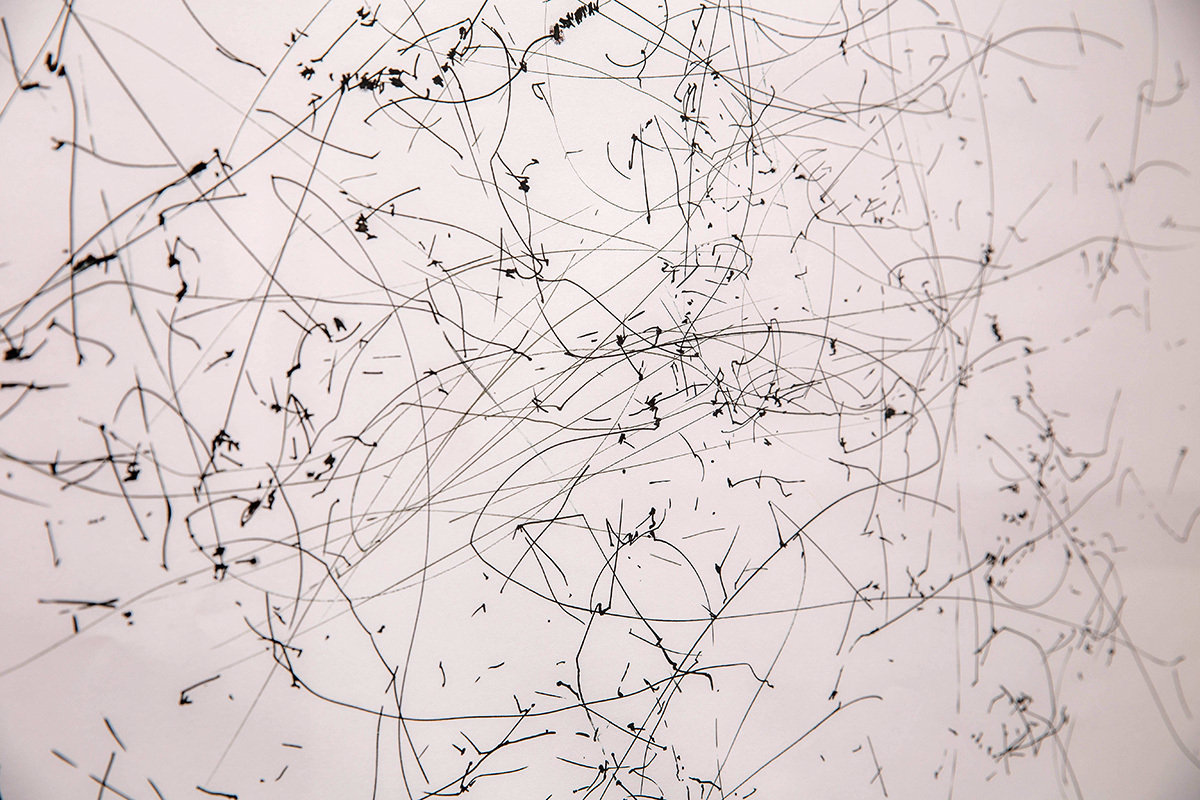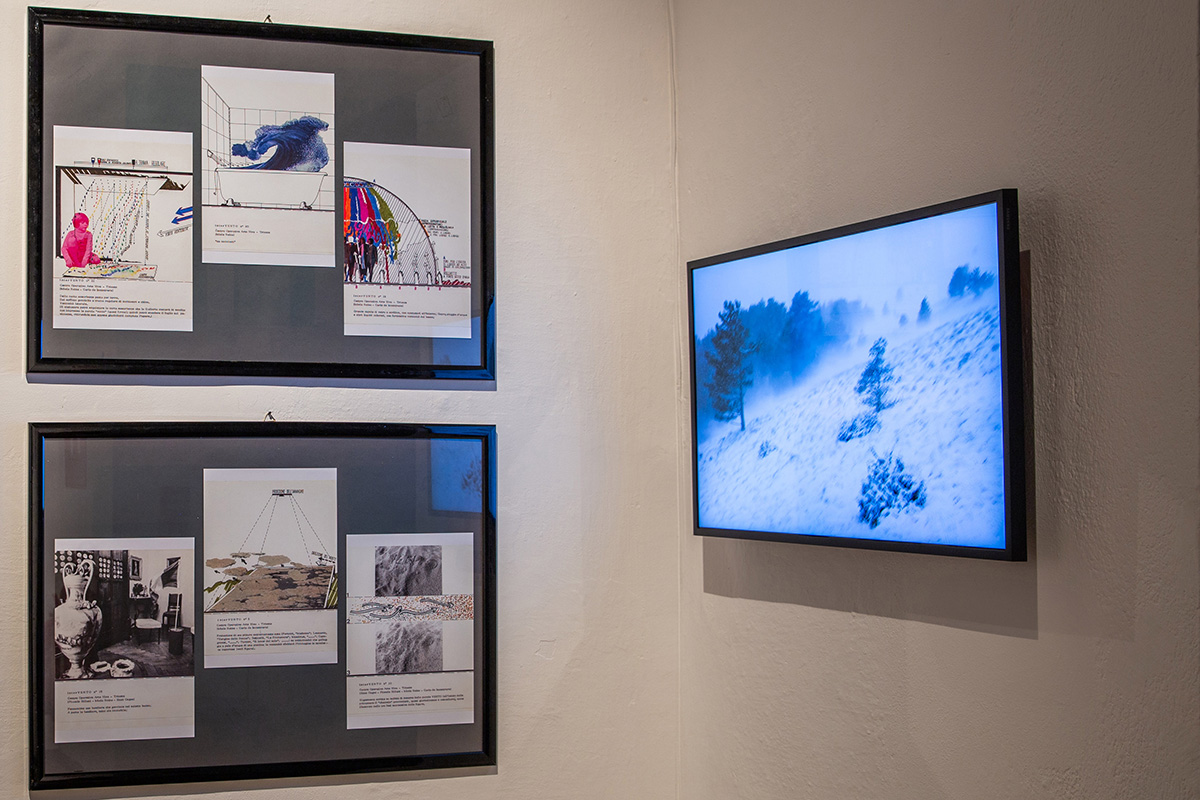
preVETRItev/interVENTI in castello
At Kromberk Castle, in the first-floor foyer, you can visit the temporary exhibition "preVETRItev/interVENTI in castello," curated by Katarina Brešan and Massimo Premuda. The exhibition displays selected projects by Miela Reina and her Trieste colleagues, placed in dialogue with works by Vasja Žbona, from the art collection of the Regional Museum Goriški muzej, along with three contemporary artists.
In 1970, Miela Reina (Trieste, 1935–Udine, 1972), along with fellow artists Enzo Cogno, Carlo de Incontrera, and Mario Sillani from the "Centro Operativo Arte Viva" association in Trieste, created a series of 22 imaginative projects titled "interVENTO." Inspired by a characteristic element of the city of Trieste, these projects were part of the "Studia 970 2" initiative in Varese, invited by Luciano Giaccari, a pioneer in artistic video and the initiator of an extensive archive. The resulting work is an ironic and fairy-tale like series of ideas, made particularly appealing today by the immediacy of the sketching technique, encompassing many themes, techniques, and solutions dear to the artist, from drawing to collage, projection to happening, and from pictorial-scenic objects and figures to comic narratives.
A notable invention from Reina's visual narrative alphabet is the "shabby little machine" called the eolophone, created in collaboration with composer Carlo de Incontrera (Trieste, 1937). The idea was that, once activated, it would make all the glass in a space vibrate, each with its own characteristic, or even, if placed in nature, be played only by professional musicians. Photos of this happening, without an audience, were taken by Mario Sillani Djerrahian (Addis Ababa, 1940) in the park of Villa Revoltella, in dialogue with the 19th-century greenhouse and English garden.

Reina's works are placed in dialogue with some assemblages by Vasja Žbona (Miren, 1945–Paris, 2013), showcasing a more playful and almost Dadaist side of this sculptor. Despite living in Paris, Žbona found inspiration mainly in the nature of his homeland, to which he remained attached. He moved from his native Miren to the Paris metropolis and entered the circle of Cuban artist Augustín Cárdenas. As his assistant, he adopted Cárdenas' surrealist approaches and so-called biomorphism, abstracting forms from the plant world. For his works, which he called "tiny grains of wind," Žbona used various materials, bronze, stone, but especially loved different types of wood, whose lines and shades create ever-new compositions. In his series of assemblages, he managed to gather everyday objects that were no longer useful and, with subtle irony, transformed them into small, almost utopian, poetic compositions, freely crossing the boundaries of the conventional. This artistic nature is also reflected in the short poems he loved to write in French, sounding like glimpses of fleeting moments: Feuille rouge d'automne / Chaloupe / Au vent qui passe (Red autumn leaf / Boat / In the passing wind).
Among these historical explorations, we encounter the unusual work of sound artist Michele Spanghero (Gorizia, 1979), who focuses on technologically and conceptually refined sound sculptures. This time, he presents a playful drawing on paper with markers titled "Pictura vento boreale," created as an attempt to visualize something invisible, the volatile substance of air, through its dynamic appearance in the form of wind. Spanghero decided to tie markers to the branches of a tree and let the movement of the branches, shaken by gusts of the bora wind, draw graphic strokes on paper. The result is thus the product of a natural process, where the artist restrains his subjective will and brackets his role as the material author, allowing the natural phenomenon to assert itself and reveal its randomness.

The exhibition continues with two refined black-and-white triptychs by photographer Furio Scrimali (Trieste, 1959), depicting the fury of the bora wind on the Karst landscape. In the first triptych, the artist shows the effects of the cold north wind on water, transforming it from snow to ice, shaped into incredible forms by the gusts. From the Karst drifts, where light and dark bora intertwine, a true sculptural work emerges. In the triptych dedicated to dry stone walls, characteristic Karst constructions built to defend against the strong wind, he highlights the work created by humans, using stone to mark our natural and cultural landscape. Scrimali is fascinated by the ancient graphic characteristics of these rural constructions, which UNESCO rightly included in the list of intangible cultural heritage in 2018. With the triptych, he reflects on the balance and craftsmanship of the construction, seeking silent stories of countless people within them.
The exhibited works are accompanied by the sound installation "Bora - Breath of Absurdity" by Jesus Valenti More Castro (Venezuela, 1994). This sound project, dedicated to the Trieste bora, is a sound composition that transforms the city's famous wind into a true auditory experience. The wind, recorded in various situations, becomes raw material for complex acoustic manipulation, inspired by musical counterpoint techniques, where the theme is treated in multiple ways. The work combines nature and technology, order and chaos, leading the listener to rediscover the wind through music, in a continuous play between the audible and the invisible.

The exhibition was created in collaboration with the Miela Reina Archive and the Bora Museum, as part of the tenth edition of the Energy of Spaces - Wind and Stone Festival, titled Karst Polyphony, organized by the Casa CAVE association from Vižovlje with the support of the Autonomous Region of Friuli Venezia Giulia, the Municipality of Duino Aurisina, and the Pietro Pittini Foundation.
(Photo: Katarina Brešan)
Location: Kromberk Castle
From:
28 Nov 2024
Till:
26 Jan 2025
curators:
Katarina Brešan and Massimo Premuda